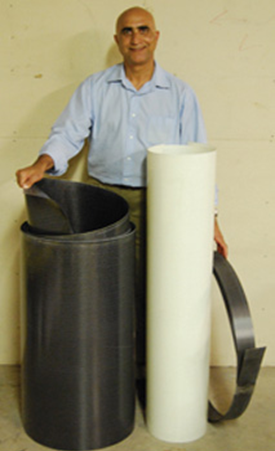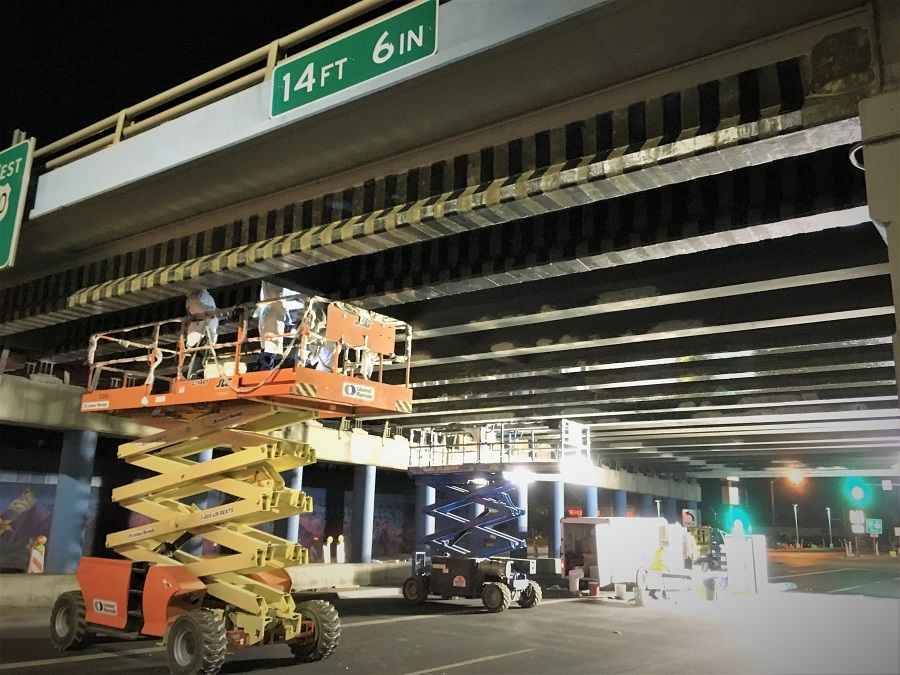Introduction
What is FRP?
Fiber Reinforced Polymer (FRP) is comprised of a polymer (such as epoxy, vinyl-ester, or polyester) that is reinforced with a fiber (such as carbon, glass, Kevlar, basalt, etc.); thus the name Fiber Reinforced Polymer or FRP. The fibers are the main source of strength and stiffness in FRP. The resin serves two primary purposes: a) it distributes the load among all fibers, and b) it protects the fibers from environmental effects such as abrasion, etc. FRPs have physical properties that are different when measured along different axes or directions. By orienting the fibers in the desired direction, one can achieve the required strength in each direction. This behavior, known as anisotropy, offers unique advantages for efficiency when designing with FRP products.
Origins of FRP for structural repair
The original technique of using FRP for the repair and retrofit of structures, known as the wet layup system, was pioneered in the late 1980s by Professor Ehsani and his associates at the University of Arizona.

The wet layup system involves saturating fabrics made of glass fiber or carbon with epoxy resin in the field, which are then applied to concrete structures. The resulting FRP has excellent mechanical properties due to the reinforcement material, such as high tensile strength and stiffness provided by the fibers. Tensile strength of FRPs used in the construction industry is 3 to 5 times that of steel. Additionally, the polymer matrix provides corrosion resistance and protects the fibers from environmental effects, abrasion, and vandalism. The manufacturing process for FRP involves orienting the fibers in desired directions to achieve the required strength along different axes or directions.
Advantages of FRP in construction
FRP has the highest strength-to-weight ratio of any construction material, making it three to five times stronger than steel while also being significantly lighter. This property allows for easier transportation and installation without the need for foundation adjustments.
Bonding of FRP to the exterior surface of a structural element such as a wall, beam or slab allows strengthening of these elements without enlargement of the element being repaired.
Additionally, FRP is corrosion-resistant and does not degrade like traditional materials such as wood or steel. Its waterproof nature and chemical protection make it suitable for a variety of applications in the construction industry.
Furthermore, FRP offers rapid repair capability and versatile usage in bridges, pipelines, pedestrian pathways, parking garages, and other structures. Overall, FRP provides numerous advantages over traditional building materials with its exceptional durability and low maintenance requirements.

| Advantages | Description |
|---|---|
| High tensile strength | FRP is three to five times stronger than steel |
| Low weight | Lightweight nature enables easy handling and transportation |
| Corrosion resistance | Resistant to degradation from environmental factors |
| Rapid repair capability | Allows for quick restoration of damaged structures |
| Versatility | Suitable for a variety of applications in the construction industry |
| Size adjustment | Ability to cut the fabric in the field to the required size minimizes construction delays |
| Slowing corrosion rate | FRP creates an impervious barrier (like a reinforced paint) that stops the corrosion process |
| Minimal investment compared to complete structural replacement | Provides cost savings compared to replacing an entire structure with alternative building materials |
Why repair using FRP?
Repairing deteriorated and corroded materials or accidental damage using Fiber Reinforced Polymer (FRP) offers a cost-effective solution, with studies showing that FRP repairs can extend the service life of structures by decades. FRPs provide several advantages for repair applications. Firstly, they exhibit excellent chemical resistance, making them suitable for corrosion repair in various industries such as water and sewer treatment facilities, industrial processing plants, and marine infrastructure. Additionally, FRPs are lightweight materials that do not add significant weight to the structure being repaired. This is particularly beneficial when repairing composite structures such as bridges or aircraft components, where maintaining weight efficiency is crucial. Moreover, FRPs offer high impact resistance, ensuring durability and long-term performance of repaired structures. Overall, the wide range of benefits provided by FRPs makes them an ideal choice for repairing and strengthening deteriorated and aging infrastructure or addressing accidental damage in various industries. Emergency repair of old failing pipelines with FRP, for example, has gained popularity in recent years.
Properties of FRP
This discussion will focus on the properties of FRP, specifically its strength and durability, corrosion resistance, lightweight characteristics, versatility and range of applications, and cost-effectiveness. FRP composites have the highest strength-to-weight ratios, making them stronger than conventional construction materials pound for pound. They also exhibit good fatigue properties and impact resistance, making them suitable for various applications such as strengthening bridge girders. Additionally, FRP materials demonstrate high levels of corrosion resistance and thermal insulation properties. Their versatility allows for easy repair and strengthening of complex shapes and design flexibility. Moreover, FRP is a cost-effective option due to its long-lasting durability and low maintenance requirements.
Strength and Durability
Strength and durability are key characteristics of Fiber Reinforced Polymer (FRP), making it an exceptional material for various applications. FRP exhibits high tensile strength, surpassing that of steel, which allows it to withstand heavy loads and resist deformation. This property is attributed to the strong fibers embedded within the polymer matrix. Furthermore, FRP has a remarkable strength-to-weight ratio, making it lightweight yet capable of supporting significant loads. In terms of durability, FRP is highly resistant to corrosion, unlike traditional construction materials such as steel or concrete. It does not warp, rot, or decay when exposed to moisture, ensuring its longevity even in harsh environments. Additionally, FRP possesses excellent impact resistance due to its fiberglass reinforcement. Environmentalists often complain about plastic containers that will last decades before they disintegrate in landfills. FRPs are made with higher-grade polymers and are also reinforced with fibers, giving them even longer life expectancy than conventional plastics. If there is a single application, where the longevity of plastics or FRPs becomes a beneficial attribute, it is in the repair and strengthening of our nation’s aging infrastructure. These superior properties enable FRP to excel in a wide range of applications including aerospace engineering, automotive manufacturing, infrastructure development, and marine construction. The combination of strength and durability makes FRP a reliable and versatile material choice for numerous industries seeking long-lasting solutions.
Corrosion Resistance
Renowned for its exceptional ability to withstand the relentless onslaught of corrosive elements, Fiber Reinforced Polymer (FRP) emerges as an impenetrable fortress, shielding structures from the ravages of decay and deterioration. FRP's corrosion resistance is primarily attributed to its composition, which combines the strength and stiffness provided by carbon or glass fibers with the protective properties of a plastic matrix. The use of carbon fibers in FRP creates a corrosion barrier that prevents environmental damage and degradation. This makes FRP an ideal material for applications in corrosive environments such as marine industries, where steel products are susceptible to rust and decay. Furthermore, FRP's resistance to chemicals ensures that it will not crack, chip, or peel when exposed to compounds such as deicing chemicals or salt. Overall, fiberglass composites like FRP offer a durable solution for combating corrosion and extending the lifespan of structures in various industries. Not only FRPs do not corrode, they also offer a unique solution to prevent the corrosion of other materials such as steel and concrete. Steel structures, for example, are frequently painted to insulate them from moisture and air that cause corrosion. However, the paint will crack, flake, and peel off after a few years and will become ineffective. FRPs can be thought of as a paint that is reinforced with fibers. By encapsulating a structural member such as a beam or column in a layer of FRP, the flow of oxygen and moisture that are fuel to the corrosion process is shut off. This drastically reduces the corrosion rate of the host structure.
Lightweight Characteristics
One notable advantage of Fiber Reinforced Polymer (FRP) materials is their high strength-to-weight ratio, allowing them to deliver superior strength per unit of weight compared to most metals or concrete. FRP materials exhibit this lightweight characteristic due to their composite nature, where a polymer matrix, such as epoxy or polyester, is reinforced with fibers like carbon or glass. These fibers serve as the main source of strength and stiffness in FRPs. The combination of the lightweight polymer matrix and the high-strength fibers results in significant weight savings without compromising on material strengths. A further benefit is realized from the manner in which FRP products are used. For example, in the repair of a concrete shear wall, a layer of concrete 6 inches or thicker is added to the original wall. This adds significant weight to the building that may require strengthening of the footings and foundations of the wall. In contrast, such repairs can be achieved by adding a layer of FRP that is less than 0.1 inch thick. The weight of the FRP is negligible and will not require fortifying the foundation. Similar savings are realized when repairing other structural elements such as beams, columns, and slabs. Additionally, FRP materials possess excellent impact strength, making them suitable for applications where durability is crucial. This lightweight property also facilitates easier transportation and installation of FRP products compared to heavier metal alternatives. This leads to shorter construction time and significant savings in most repair and retrofit projects.
Versatility and Range of Applications
The lightweight characteristics of FRP make it an attractive choice for various applications. However, its appeal extends beyond weight reduction. FRP offers a remarkable level of versatility and can be engineered to meet specific requirements, allowing for customization in building projects. This adaptability enables engineers to create panels of different sizes and shapes, offering aesthetic versatility as well. Construction projects are often delayed due to the wrong size of materials getting delivered to the job site. The ability to cut fabrics of carbon or glass in the field and create the right size of FRP strengthening element on the job site eliminates delays and results in massive savings in both time and cost in construction projects. This versatility opens up a wide range of applications for FRP in industries such as civil engineering, infrastructure, transportation, energy, aerospace, and more. It finds extensive use in creating strong walls and surfaces that are scratch-resistant and capable of withstanding high impacts. As a result, FRP is commonly used in pipelines, schools, hospitals, recreational facilities, and other buildings where durability is crucial.
In summary:
Product Specs:
-
- Lightweight yet strong material
-
- Customizable in terms of size and shape
-
- Non-corroding and providing corrosion resistance
Pros:
-
- Versatile material suitable for various applications
-
- Aesthetic flexibility due to the ability to customize
-
- Durable and resistant to corrosion
-
- Providing corrosion protection for host structure
-
- Significant savings in labor costs compared to conventional solutions
Cons:
-
- Materials may be higher compared to some traditional materials
-
- Requires skilled engineering expertise for proper design and installation
-
- Limited availability compared to widely-used materials like wood or concrete
Cost-Effectiveness
From an economic standpoint, the cost-effectiveness of Fiber Reinforced Polymer (FRP) materials have been demonstrated through a study that showed more than 20% reduction in construction costs when compared to traditional materials. Many of the patented products developed by QuakeWrap engineers offer unique solutions that could double or triple these cost savings. FRPs offer design flexibility and can be tailored to specific applications by combining different materials. The combination of a polymer resin, such as vinyl ester or epoxy, with reinforcing fibers, like glass or carbon, creates a composite material with superior strength and stiffness properties. This allows FRPs to be used in a wide range of applications where high performance is required. Furthermore, the base material used in FRPs is relatively inexpensive compared to other alternatives. The use of FRP also reduces maintenance costs due to its resistance to corrosion and degradation from environmental factors. Overall, the cost-effectiveness of FRP makes it an attractive choice for various industries seeking durable and efficient solutions.
More infrastucture repair using FRP
Frequently Asked Questions
What are the different types of fibers used in FRP?
The different types of fibers commonly used in FRP include carbon, glass, Kevlar, and basalt. These fibers provide strength and stiffness to the polymer matrix, allowing for tailored mechanical properties in specific directions.
How does the orientation of fibers affect the strength of FRP?
The orientation of fibers in FRP affects its strength by aligning the fibers along the load-bearing direction, maximizing their contribution to stiffness and resistance against applied forces. This unique feature of FRPs allows the design engineer to orient the fibers in desired directions to optimize strength and stiffness in specific directions.
What are the common applications of FRP in construction?
Common applications of FRP in construction include strengthening and retrofitting corrosion-damaged structures such as bridges, buildings, pipelines, seawalls, and submerged piles. For example, FRP composites have been used to reinforce aging concrete bridge decks, enhancing their load-carrying capacity and extending their service life. FRP is also used to harden structures that may be subjected to blast and explosive loads.
Are there any limitations or drawbacks to using FRP for structural repair?
Limitations of FRP for structural repair include limited fire resistance, susceptibility to UV degradation, and the need for proper surface preparation. Additionally, bonding to existing structures can be challenging due to differences in thermal expansion coefficients. However, some of the patented solutions developed by QuakeWrap engineers overcome most of the limitations.
How does FRP compare to traditional materials like steel or concrete in terms of cost and performance?
Although FRP materials cost more than concrete or steel, FRP offers significant cost savings when both materials and labor costs are considered. The lightweight, ease of installation and long-term durability of FRP result in far greater savings beyond the slightly higher materials cost. In terms of performance, FRP can have comparable or even superior strength-to-weight ratios compared to traditional materials like steel or concrete, making it an attractive option for structural repair and reinforcement applications.

